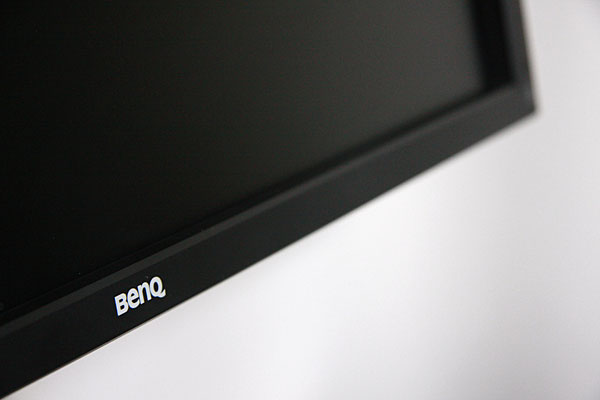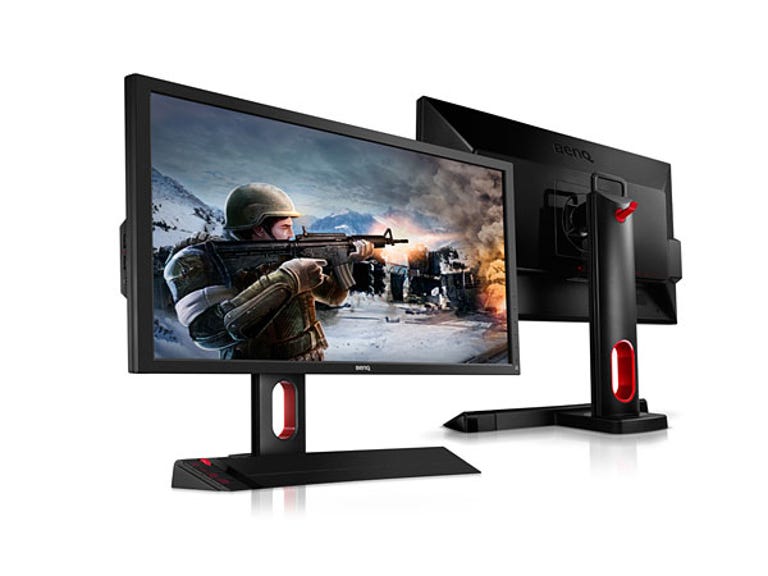 Why You Can Trust CNET
Why You Can Trust CNET BenQ XL2420T review: BenQ XL2420T
Despite the extra frills, the XL2420T isn't a massive jump, performance wise, above the XL2410T. Still, if seriously smooth gaming performance is your only concern, take a look.
There really is only one reason to buy a TN-based monitor these days: 120Hz. Double the refresh means your games are able to show double the frame-rate of conventional monitors (graphics card willing). Of course, it also means support for Nvidia's 3D glasses, but this is the consolation prize compared to the silky smooth frame rates.
The Good
The Bad
The Bottom Line
So we have BenQ's XL2420T, the follow up to its lower-numbered XL2410T. The same two serious gentleman are on the box, although there's been a hefty revision to the industrial design.

BenQ's new design is a little more streamlined.
(Credit: Craig Simms/CNET)
Specs at a glance
| Size | 24 inches |
|---|---|
| Resolution | 1920x1080 |
| Aspect ratio | 16:9 |
| Pixel pitch | 0.272 |
| Panel technology | TN |
| Viewing angles (10:1 contrast) | H: 170° V: 160° |
| Response time | 2ms GTG |
| Max vertical refresh | 120Hz |
| Connections | DVI, DisplayPort, 2x HDMI, VGA, 3xUSB 2.0 downstream, 1xUSB 2.0 upstream, 3.5mm line out |
| Accessories | DVI, power cables |
Stand and ergonomics
BenQ's efforts with its stands have been historically good, and the full range of tilt, swivel, rotate and height adjustment are in play here. There's a hole in the neck for cable management, and a hook at the top for hanging cables or other devices. A handle at the top makes carrying a little less awkward, once you've adjusted the screen's height down as far as it will go. We did find it exceptionally hard to remove all the protective plastic from the stand, as a certain amount seemed to be trapped between two bits of plastic near the top — make sure to have a sharp knife on standby to finish the job.
BenQ's stand gives the full range of adjustability.
(Credit: Craig Simms/CNET)
Connections
USB remote port, DisplayPort, VGA, DVI, 2x HDMI, USB 2.0 upstream and USB 2.0 downstream (from left).
(Credit: Craig Simms/CNET)
Two USB 2.0 ports and a headphone port are on the left hand side.
(Credit: Craig Simms/CNET)
The ridge on the left-hand side of the remote allows it to be nestled into the foot of the stand.
(Credit: Craig Simms/CNET)
The bundled "S Switch" remote isn't exactly a game changer, but it could potentially make dealing with the monitor a little quicker. The scroll wheel and back button are used to navigate the OSD, while the bottom three buttons can be set as shortcuts for different monitor functions. By far, the most useful function is to treat it as an input switcher.
Buttons and on-screen display (OSD)
The capacitive buttons aren't very responsive.
(Credit: Craig Simms/CNET)
BenQ's finally managed to front-mount its buttons, however, it's also made them capacitive. While this is fine in theory; in practice, you can't hit the buttons too quickly or the monitor simply won't record your press. You have to wait until the OSD shows that you've made an action, then press again, which could lead to frustration as you're making your way through the menus. Every single press will also result in an incredibly annoying beep, something you can thankfully turn off in the OSD.
The buttons are backlit though, and the menu is context sensitive and a great step forward for BenQ.
Context sensitive OSD? Yes, please.
(Credit: Craig Simms/CNET)
BenQ's got all the regular screen options you'd expect, plus a few unique functions. One of those is what it calls "Black eQualizer", which, for all intents and purposes, appears to be gamma adjustment. The gambit is that gamers can now see more detail in dark areas, and it works rather well in this function.
Scaling options are also impressive. 1:1, full screen and aspect stretch are in there, but you can also emulate monitor sizes, including 17-inch 4:3, 19-inch 4:3 and 16:10, 21.5-inch 16:10 and 23-inch 16:9. We'd advise against using any of the latter modes, as the image ends up looking quite blurry. Stick to 1L1, full screen and aspect.
Other standout features include overscan adjustments for HDMI, and the ability to turn off automatic switching to HDMI if one of the other inputs turns off.
There are also presets you can download and an FPS mode that adjusts the image to try and give you a competitive edge — whether or not you think this makes a difference is personal preference.
Performance
Lagom.nl LCD tests
After calibrating to a target brightness of 140cd/m² with an X-Rite i1Display 2, Eye-One Match 3 and tweaking with HCFR, the XL2420T was run through the Lagom.nl LCD tests.
| Image tests | |||||
|---|---|---|---|---|---|
| Contrast | Sharpness | Gamma | Black level | White saturation | Gradient |
| Pass | Pass | Pass | Pass | Pass | Very slight banding, purple discolouration at dark end of the gradient. |
The XL2420T did reasonably well with the basic Lagom.nl tests, only showing slight problems with the gradient test.
| Inversion pixel walk tests | ||||||||||
|---|---|---|---|---|---|---|---|---|---|---|
| Test 1 | Test 2a | Test 2b | Test 3 | Test 4a | Test 4b | Test 5 | Test 6a | Test 6b | Test 7a | Test 7b |
| Turns green | Turns green | Pass | Turns purple | Turns purple, slight flicker | Turns purple | Pass | Pass | Pass | Turns purple | Turns purple |
While we're usually looking for flickering in these tests, the XL2420T had a bizarre property of turning images that are meant to be greyscale either purple or green. We've only seen this once before, with the Asus PA246, an IPS screen.
Input lag
Measured against a Samsung SyncMaster 975p CRT, and using a Canon 40D set to a shutter speed of 1/320, an average of over 60 photographs were taken using StoppUhr. Lag time was completely negligible — the XL2420T is definitely good for gaming.
HDMI performance
While a monitor might have an HDMI port, there's no guarantee that it'll display images as expected. We hooked up a PlayStation 3 and checked for 24p capability and judder, as well as running the HQV Blu-ray test to see how well it coped with an interlaced source and noise.
| 24p capable | Understands YUV | Mission Impossible III scene 11 judder test | Mission Impossible III scene 14 judder test |
|---|---|---|---|
| Yes | Yes | Judder | Judder |
| HQV noise reduction score | HQV video resolution loss score | HQV jaggies score | HQV film resolution loss score | HQV film resolution loss — stadium score | Total score out of 100 |
|---|---|---|---|---|---|
| 0 | 0 | 0 | 0 | 0 | 0 |
The XL2420T copes best with progressive input, and is probably best suited for gaming consoles. For movie watching, it doesn't provide the best experience from a dedicated device over HDMI.
Viewing angles
Viewing angles were taken with a Canon 40D in spot-metering mode, with only shutter time adjusted to obtain a good exposure.
As you can see, images quickly become washed out as we turn to the side, common for TN panels. Interestingly, the colours invert sooner on the bottom vertical than usual, then flipping back to normal when you go past this point.
(Credit: Craig Simms/CNET)
Light bleed
The XL2420T isn't the best when it comes to light bleed — on a pure black screen, obvious bleed entered from all sides on our review sample.
It's important to note that the effects of light bleed will likely change from monitor to monitor, regardless of make.
Power consumption
We measured power consumption using a Jaycar mains digital power meter. It's important to note here that, due to limitations of the meter, measurements are limited to values of 1W and greater, and are reported in 1W increments.
All measurements, screen brightness and contrast were set to 100 per cent, and a test image was displayed.
| Juice Box |  |
|---|---|
| Maximum power draw | 24W |
| Power-saving mode | <1W< td=""> |
| Off | <1W< td=""> |
BenQ has focused highly on power efficiency in the last few years, and it shows again with the XL2420T.
Warranty
The XL2420T is covered by BenQ's fantastic four-year, zero-dead pixel, on-site pickup warranty.
Conclusion
Despite the extra frills, the XL2420T isn't a massive jump, performance wise, above the XL2410T. Just like its predecessor, it suffers from light bleed, as TN panels are wont to do due to lower manufacturing tolerances, and the colour shifting on the inversion tests is a little worrying. Despite the screen's issues, the 120Hz mode is still gorgeous, and the panel is highly responsive for gaming. If seriously smooth gaming performance is your only concern, take a look.


